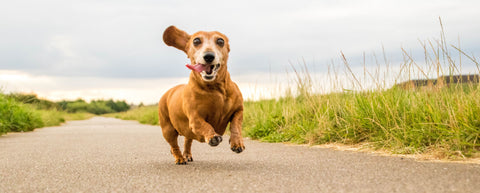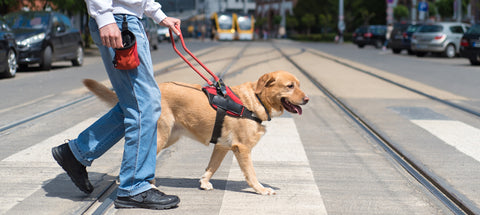Spring has arrived, bringing warmer temperatures, melting snow, and the need to shake off those winter blues. It’s the perfect time to get outside with one’s dog for fun, new outdoor adventures.
1. Enjoy the spring weather
After a long, cold winter, spring is the perfect time to enjoy the soft spring breezes, warmer temperatures, and renewed greenery. Dogs love the fresh springtime smells, sounds, and sights that unlock only during this time of the year.
Take it slow on that first springtime walk. Start with a light, short walk, and work your way up to a longer walk when your dog is ready.
2. Create a plan to get out and move
Develop a dog walking plan that considers the pet’s age; older dogs move a bit slower than a younger pup. Things to consider when walking an older dog:
- How far and how long the dog can walk – Don’t expect a senior dog to be able to take the same long walk they enjoyed as a young dog. You may need to adjust how fast and how far you go when walking an older dog, especially one with stiff joints.
- Spring weather walking conditions – the temperature and the weather can change quickly in the spring. Avoid early morning, and late-night walks on colder days. Try walking your best friend mid-day, when the sun’s out.
- Choose the right route – an older pet may do better navigating firm, even surfaces and sidewalks. Walking on dirt or gravel walkways may be more challenging for a senior dog.
- The dog’s mobility – understand your dog’s limitations when picking your route. Is the walk going to be strenuous for them? Mobility needs change in older dogs, and stiff joints or reduced mobility can impact your dog’s ability to keep up.
Older dogs with stiff joints should avoid high-impact exercises like running, jumping, or playing fetch. If you need help deciding on the right exercise plan for your dog, be sure to talk to your veterinarian.
3. Inspect the dog’s harness and leash
Make sure the dog’s harness and leash are made with quality materials. They should be snug enough so they don’t sag or allow the dog to escape but taut enough so one’s pet will know the direction the owner wants to walk.
4. Check the dog’s mobility
As dogs get older, we notice them slowing down. It’s important to check a dog’s mobility. Some easy-to-spot signs of joint stiffness include:
- In the morning or after resting
- Slowing down on walks
- A reluctance to get out of bed
- Unwillingness to go up or down the stairs
- Lethargy and tiredness
- Grumpiness during or after walks or even when being petted.
A dog’s behavior and activity level changes can indicate an underlying . If your dog is showing any signs of joint stiffness, talk to your veterinarian about how you can help ease your dog’s joint discomfort and help keep your best friend active.
5. Provide a high-quality dog hip and joint supplement, like YuMOVE
YuMOVE’s quest for quality is what led to a unique and proprietary Green Lipped Mussel profile called ActivEase®Green Lipped Mussel. Sustainably sourced in the crystal-clear waters of New Zealand, YuMOVE’s ActivEase®Green Lipped Mussel contains a unique blend of nutrients including Omega-3 fatty acids, amino acids, and antioxidants to support your dog’s joint health and mobility.
Looking for more information?
Click here to learn more about YuMOVE’s ActivEase®Green Lipped Mussel process.
Click here to learn more about the ingredients within every YuMOVE dog joint supplement.
YuMOVE, the UK’s #1 veterinary hip and joint supplement brand*, already supports two million+ dogs a year globally*. For years, YuMOVE has been providing a high-quality dog hip and joint supplement that’s scientifically proven to work in just six weeks.* There’s also a 60-Day Money-Back Guarantee*, if not satisfied.










